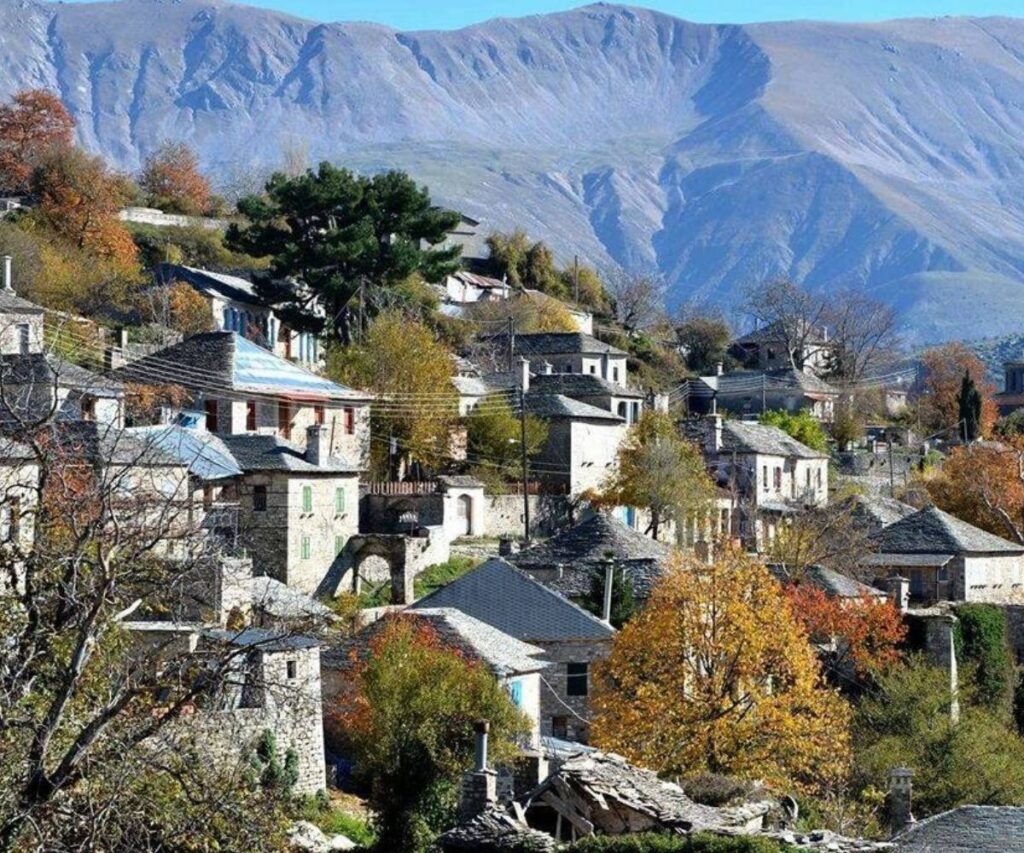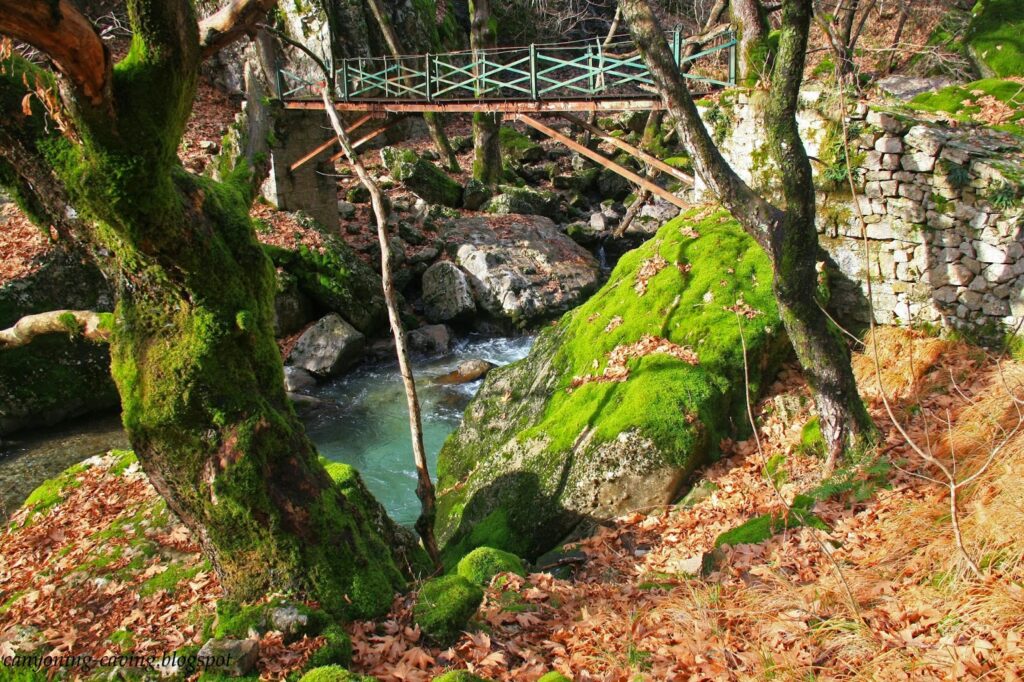Christmas in Tzoumerka? Yes! Among the best places one can choose to rest and recover in a special environment with a landscape of wild beauty, ravines, endless cobbled streets in stone-built villages, monasteries and churches hanging from cliffs, small and large waterfalls, rivers with rapid and calm water forming hidden lakes. Whatever you dream of for a unique experience in nature, it is here.
The Athamanian Mountains, one of the largest mountain ranges in western Greece, cross the prefectures of Ioannina and Arta and climb upwards towards the sky; to visit the dozens of its beautiful villages, one must follow a serpentine road that stops at each small village – however, the place finds various ways to compensate you for your journey and your choice.
Syrrako, Kalarites and Katsanochoria; between them roar the waters of the rivers Arachthos, which in winter swell and climb high on the surrounding rocks, and Kalarritikos, there, far down on the bottom of the ravine below the village of Kalarrites, which is famous for its unique beauty.
*After climbing for several kilometers we reached the hill opposite the two villages, Syrrakos and Kalarrites, where, for a long time, we stood speechless at the beauty before us. As if perched on two mountain slopes, joined by a path, they seem to enjoy the tranquility of nature, under the blue sky.
*We parked the car outside the village of Kalarrites and started walking towards our accommodation first and then we entered the village for a tour of the streets; the village is built on a steep slope which means that the houses on top of the slope are quite far from the houses on the edge of the ravine.

*In Kalarrites we also visited the old primary school, which is behind the square. The school dates back to the beginning of the 20th century and ceased to function as a school in 1981. Today it functions as the Kalarriters’ history and folklore museum and as a conference center.
*People were gathered in the village square. Residents and visitors talked to each other, some took pictures, and others admired the surrounding environment. Here there is a marble pillar inscribed with the names of the villagers who were men of letters and excelled in trade during the 18th and 19th centuries. They were members of the secret society Filiki Eteria (“Friendly Union”) and leaders of the Kalarrita Revolution in July 1821.
*Next to the marble column with the Filiki Eteria members is a sign that leads us to the church of Agios Nikolaos where we find the remarkable wood carving of the Metsovit carvers. We passed the ruins of the house of the Voulgaris family (Sotiris Voulgaris – the founder of the famous jewelry brand Bvlgari), which is next to the Fitrou fountain and opposite the place where they had their workshop. Walking towards Agios Nikolaos (c. 1480) we are impressed by the height and color of the high dome and the old clock. From here we have a view towards the mountains of Tzoumerka, right up to the villages of Pramanta and Pouliana.
*Drink water from as many of the dozens of running water sources as you can. Each of these has different water quality that suits different needs and the residents use it accordingly. That which suits the digestive system, that which is tasteless, that which is metallic, that which is heavy or that which is suitable for cooking legumes, and they give their unique character to the everyday life of the local people.
*The springs have a name and a history…so find out and drink fresh and clean water from the springs of Parashis, Bazakis, Bargiannis and all others…
*Don’t forget to spend time admiring the well-known bridges that are inside the village in the area of Minza and Turtouri but also outside the village, such as the Gogou suspension bridge in Kalarritiko, a work of the German engineer Baykman (c. 1935), the Kouyasa bridge or Chali bridge.
*If you come during the summer in the month of July, you have the opportunity to meet the inhabitants of five Vlach-speaking villages in the area (Kalarrytes, Syrrako, Paleochori, Vathypedo and Matsouki), who visit the village every year. Different parties take place in rotation in any of the above mentioned villages and last for 2 days. Various associations and cultural associations participate, with dance groups, traditional events and references to the history, customs and traditions of the villages.
*At the point where the Syrrakos and Kalarrites join is the famous and largest single-arched bridge in the Balkans, the Plaka Bridge. (Here we ended the journey by going rafting on Arachthos, a fantastic experience that I will tell you about some other time).
*The distance that separates the two villages is approximately 1,500 meters.
We also followed this green beautiful path. We took the route from Syrrakos to Kalarrites. A wooden sign that reads “Chrousia river – Kalarrites” informs us that it is time to leave.

*For 30 minutes we went downhill, which made us think we should save energy for our return journey, as this part of the road would now be uphill. We stopped to take several photos by the river and continued to the square of the second village, where we rested and headed back. Estimate an hour and a half there and another hour and a half back.
*On our routes through the cobblestoned streets of the village of Syrrako, we admired the mansions with the arched entrances, the stone-built houses with the slate roofs and drank cold, fresh water from the stone fountains Kondol, Dyo Vryses, Psallida, Tsakiri until we reached the square.
*In the square we saw two tall and shaggy old plane trees dominating, as well as the covered stone fountain Goura. We stopped for a long time to listen to the sounds of the village but also to greet passing residents and visitors who conveyed their impressions of the routes they took to Tzoumerka and the villages they returned to in the area.
*Famous Greek personalities have their roots here, such as the great poet and writer Kostas Krystallis, whose father’s house has been turned into a folk art museum. In a nostalgic poem entitled “To the Golden Eagle” he wrote about his birthplace: “I want the spring of water, the ravine -my darlings- to offer me their immortal water as a cure, I want the birds of the steppe to rock me to sleep and wake me in the morning with their chirping…”
*The famous poet and activist of the 1821 freedom revolution, George Zalokostas, also comes from Syrrakos, he was especially loved through his poem, which refers to the cold winter in his village and the sad moments he and his wife experienced when their children died during it : “The northern wind that freezes the lambs”.
*On the Square with the statues in the center of the village you can see busts of the first parliamentary primeminister, Ioannis Kolettis (1774-1847) who originates from Syrrakos and of the poet Zalokostas, as well as an altar of honor for those who fell for the freedom struggle of Syracuse on November 23, 1912.
